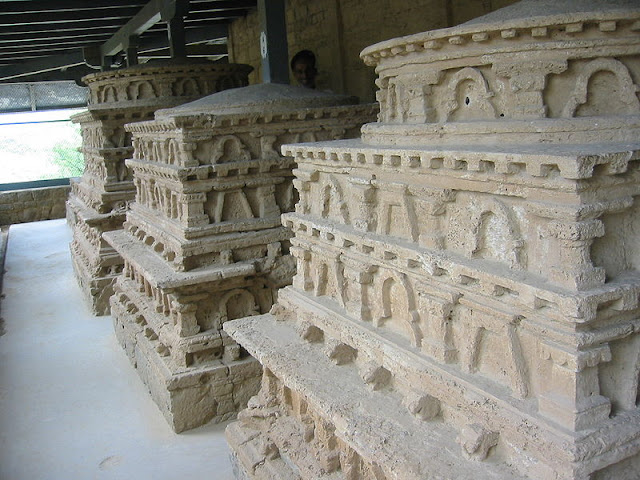Taxila
The world ”Taxila” is
being inferred from the word “Takshasila” which Means “City of Stones”. Taxila
had been the cradle of the world’s greatest civilization in the history. taxila
is the place where Gandhara civilization and sculpture art roots and
flourished. There are excavated ruins of three prominent cities Bhir Mound,
Sirkap, and Sirsukh. There are also many important ministries, Stupas and
palace excavated all among the Taxila valley.
Taxila was conquered by Alexander in 327 BC. It latter came
under the Mauryan dynasty and
attained a remarkably mature level of development under the great Ashoka. Then appeared the Indo-Greek
descendants of Alexander’s warriors and finally came the most creative period
of Gandhara. The great Kushan dynasty was established
somewhere near 50AD.During the next 200 yeas Taxila become a renowned center of
learning, philosophy and pilgrims and traveler were attracted to it from as far
away as China and Greece.
 |
| Taxila |
 |
| Foreigner visiting Taxila Meseum |
THE ANCIENT TAXILA.
Taxila is one of the
most famous archeological treasures of Pakistan and was once an important city
of the kingdom of Gandhara. The history of Taxila spans about 4000 years, and
it’s development has been influenced by successive invaders from different
parts of the world. Though Taxila may rightly be called a cultural melting pot,
the capital of the various empires that succeeded one another in the area.
When the Ghandara kingdom was absorbed by the Achaemenid Empire in 516 BC, Taxila
became the capital of this eastern Persian province. The first city of Taxila
dates from this period and is today referred to as Bhir Mound. Its original
name was Taksashela, i.e. city of snakes, which was subsequently altered
gradually by Greek historians to Taxila. By the late fifth century BC, Taxila
had become the site of the best-known University in the subcontinent, which
offered courses in mathematics, law, history, medicine, social sciences, the
arts, astronomy and military tactics. It was here that the great Sanskrit
scholar Panini compiled his Sanskrit grammar. The Kharoshti alphabet, derived
from Persian Aramaic alphabet, was also developed about this time and subsequently
became the national script of Gandhara.
In 326 BC Alexander the
Great arrived at Taxila and made it one of his garrisons. Later on it was
invaded by Mauryans during the period of Ashoka the Great, who became a
Buddhist in 272 BC. It was because of Ashoka that Buddhism spread to central
Asia, Tibet and China. Disaster struck Taxila when the White Huns burned the
city and the monasteries. The city never really recovered after that to got
it’s lost glory. Huns were replaced by Kabul Shahi and Hindu Shahi empires and
finally fell in about the year 1000 to the first great Muslim conqueror,
Mahmood of Ghazni.
 |
| Taxila |
 |
| Taxila |
 |
| Foreigners visiting Taxila Meseum |
PRESENT DAY
TAXILA/TAXILA CANTT.
Present day Taxila is
situated about 27 KM from Rawalpindi on Peshawar road. Sandwitched between
Nickolson monument on one side and Wah Cantonment on the other. This beautiful
valley lies quietly, between Khanpur Dam and Margalla Hills. Ruins of Buddhist
monasteries and stupas are visible even from the G.T. road and attract the
tourists from all over the world.
 |
| Taxila |
 |
| Taxila |
If you want to get Pakistan please visit:
Please like and comment :)
.jpg)

Comments
Post a Comment